Hanif Livani
Robust Event Classification Using Imperfect Real-world PMU Data
Oct 19, 2021



Abstract:This paper studies robust event classification using imperfect real-world phasor measurement unit (PMU) data. By analyzing the real-world PMU data, we find it is challenging to directly use this dataset for event classifiers due to the low data quality observed in PMU measurements and event logs. To address these challenges, we develop a novel machine learning framework for training robust event classifiers, which consists of three main steps: data preprocessing, fine-grained event data extraction, and feature engineering. Specifically, the data preprocessing step addresses the data quality issues of PMU measurements (e.g., bad data and missing data); in the fine-grained event data extraction step, a model-free event detection method is developed to accurately localize the events from the inaccurate event timestamps in the event logs; and the feature engineering step constructs the event features based on the patterns of different event types, in order to improve the performance and the interpretability of the event classifiers. Based on the proposed framework, we develop a workflow for event classification using the real-world PMU data streaming into the system in real-time. Using the proposed framework, robust event classifiers can be efficiently trained based on many off-the-shelf lightweight machine learning models. Numerical experiments using the real-world dataset from the Western Interconnection of the U.S power transmission grid show that the event classifiers trained under the proposed framework can achieve high classification accuracy while being robust against low-quality data.
Event Cause Analysis in Distribution Networks using Synchro Waveform Measurements
Aug 25, 2020
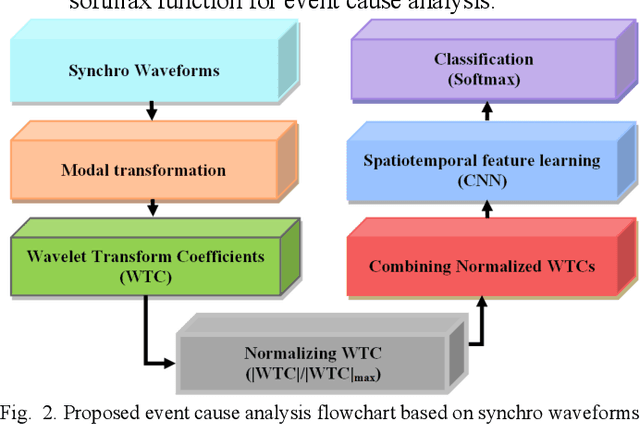
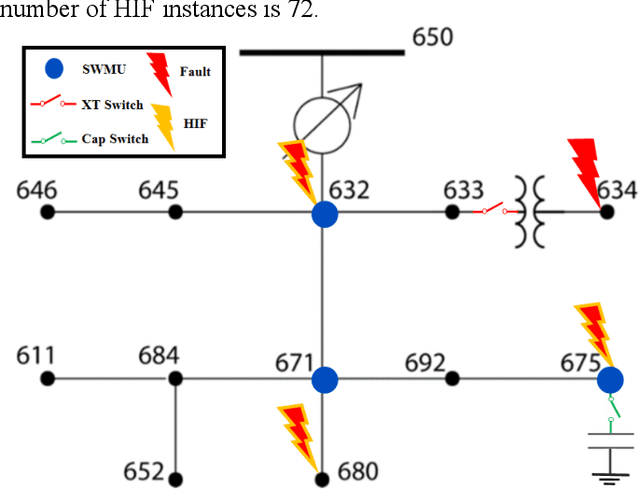
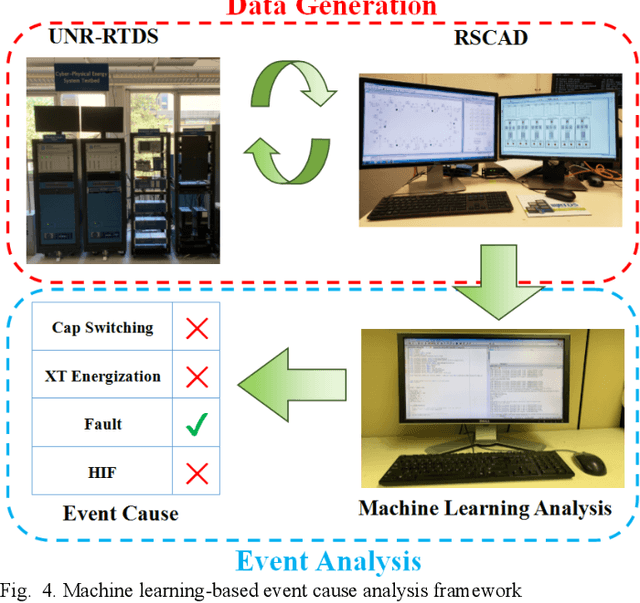
Abstract:This paper presents a machine learning method for event cause analysis to enhance situational awareness in distribution networks. The data streams are captured using time-synchronized high sampling rates synchro waveform measurement units (SWMU). The proposed method is formulated based on a machine learning method, the convolutional neural network (CNN). This method is capable of capturing the spatiotemporal feature of the measurements effectively and perform the event cause analysis. Several events are considered in this paper to encompass a range of possible events in real distribution networks, including capacitor bank switching, transformer energization, fault, and high impedance fault (HIF). The dataset for our study is generated using the real-time digital simulator (RTDS) to simulate real-world events. The event cause analysis is performed using only one cycle of the voltage waveforms after the event is detected. The simulation results show the effectiveness of the proposed machine learning-based method compared to the state-of-the-art classifiers.
Deep Neural Network based Wide-Area Event Classification in Power Systems
Aug 24, 2020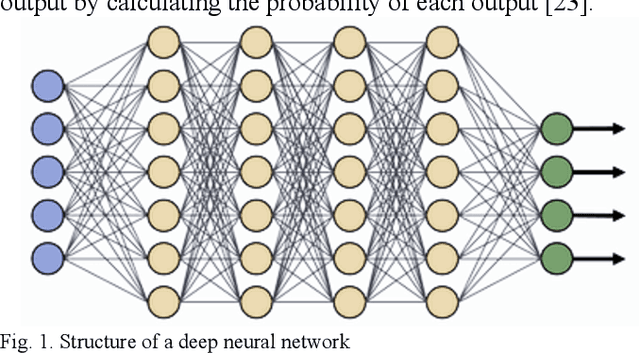
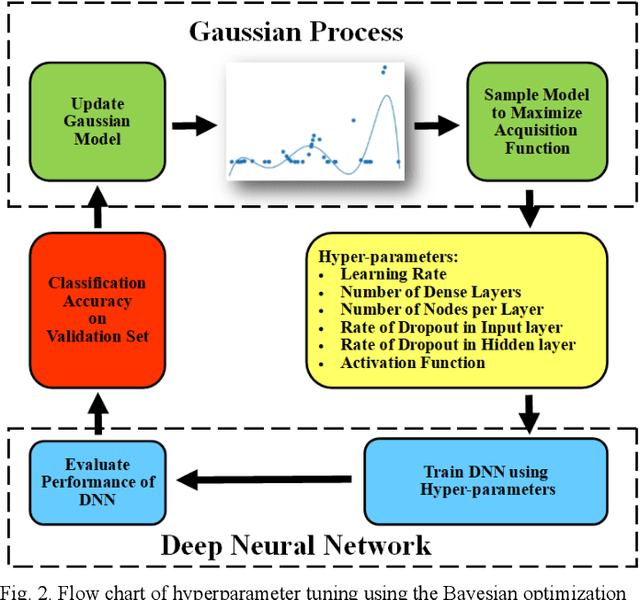
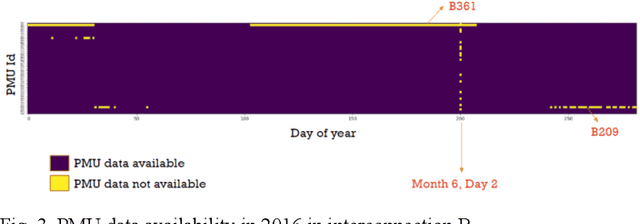
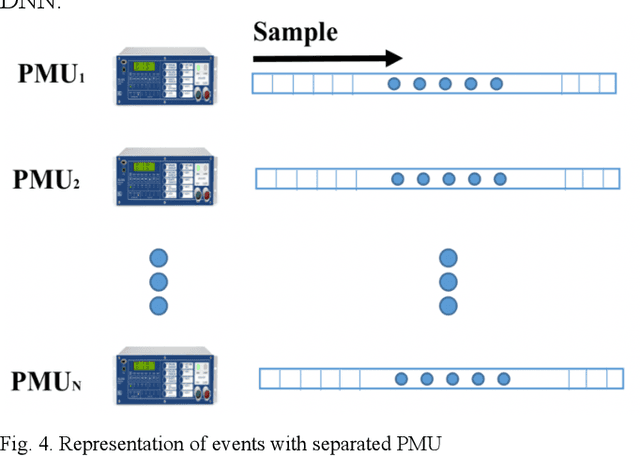
Abstract:This paper presents a wide-area event classification in transmission power grids. The deep neural network (DNN) based classifier is developed based on the availability of data from time-synchronized phasor measurement units (PMUs). The proposed DNN is trained using Bayesian optimization to search for the best hyperparameters. The effectiveness of the proposed event classification is validated through the real-world dataset of the U.S. transmission grids. This dataset includes line outage, transformer outage, frequency event, and oscillation events. The validation process also includes different PMU outputs, such as voltage magnitude, angle, current magnitude, frequency, and rate of change of frequency (ROCOF). The simulation results show that ROCOF as input feature gives the best classification performance. In addition, it is shown that the classifier trained with higher sampling rate PMUs and a larger dataset has higher accuracy.
Attack on Grid Event Cause Analysis: An Adversarial Machine Learning Approach
Nov 25, 2019

Abstract:With the ever-increasing reliance on data for data-driven applications in power grids, such as event cause analysis, the authenticity of data streams has become crucially important. The data can be prone to adversarial stealthy attacks aiming to manipulate the data such that residual-based bad data detectors cannot detect them, and the perception of system operators or event classifiers changes about the actual event. This paper investigates the impact of adversarial attacks on convolutional neural network-based event cause analysis frameworks. We have successfully verified the ability of adversaries to maliciously misclassify events through stealthy data manipulations. The vulnerability assessment is studied with respect to the number of compromised measurements. Furthermore, a defense mechanism to robustify the performance of the event cause analysis is proposed. The effectiveness of adversarial attacks on changing the output of the framework is studied using the data generated by real-time digital simulator (RTDS) under different scenarios such as type of attacks and level of access to data.
Adaptive Intelligent Secondary Control of Microgrids Using a Biologically-Inspired Reinforcement Learning
May 02, 2019



Abstract:In this paper, a biologically-inspired adaptive intelligent secondary controller is developed for microgrids to tackle system dynamics uncertainties, faults, and/or disturbances. The developed adaptive biologically-inspired controller adopts a novel computational model of emotional learning in mammalian limbic system. The learning capability of the proposed biologically-inspired intelligent controller makes it a promising approach to deal with the power system non-linear and volatile dynamics without increasing the controller complexity, and maintain the voltage and frequency stabilities by using an efficient reference tracking mechanism. The performance of the proposed intelligent secondary controller is validated in terms of the voltage and frequency absolute errors in the simulated microgrid. Simulation results highlight the efficiency and robustness of the proposed intelligent controller under the fault conditions and different system uncertainties compared to other benchmark controllers.
Cause Identification of Electromagnetic Transient Events using Spatiotemporal Feature Learning
Mar 10, 2019



Abstract:This paper presents a spatiotemporal unsupervised feature learning method for cause identification of electromagnetic transient events (EMTE) in power grids. The proposed method is formulated based on the availability of time-synchronized high-frequency measurement, and using the convolutional neural network (CNN) as the spatiotemporal feature representation along with softmax function. Despite the existing threshold-based, or energy-based events analysis methods, such as support vector machine (SVM), autoencoder, and tapered multi-layer perception (t-MLP) neural network, the proposed feature learning is carried out with respect to both time and space. The effectiveness of the proposed feature learning and the subsequent cause identification is validated through the EMTP simulation of different events such as line energization, capacitor bank energization, lightning, fault, and high-impedance fault in the IEEE 30-bus, and the real-time digital simulation (RTDS) of the WSCC 9-bus system.
Disruptive Event Classification using PMU Data in Distribution Networks
Mar 20, 2017



Abstract:Proliferation of advanced metering devices with high sampling rates in distribution grids, e.g., micro-phasor measurement units ({\mu}PMU), provides unprecedented potentials for wide-area monitoring and diagnostic applications, e.g., situational awareness, health monitoring of distribution assets. Unexpected disruptive events interrupting the normal operation of assets in distribution grids can eventually lead to permanent failure with expensive replacement cost over time. Therefore, disruptive event classification provides useful information for preventive maintenance of the assets in distribution networks. Preventive maintenance provides wide range of benefits in terms of time, avoiding unexpected outages, maintenance crew utilization, and equipment replacement cost. In this paper, a PMU-data-driven framework is proposed for classification of disruptive events in distribution networks. The two disruptive events, i.e., malfunctioned capacitor bank switching and malfunctioned regulator on-load tap changer (OLTC) switching are considered and distinguished from the normal abrupt load change in distribution grids. The performance of the proposed framework is verified using the simulation of the events in the IEEE 13-bus distribution network. The event classification is formulated using two different algorithms as; i) principle component analysis (PCA) together with multi-class support vector machine (SVM), and ii) autoencoder along with softmax classifier. The results demonstrate the effectiveness of the proposed algorithms and satisfactory classification accuracies.
 Add to Chrome
Add to Chrome Add to Firefox
Add to Firefox Add to Edge
Add to Edge